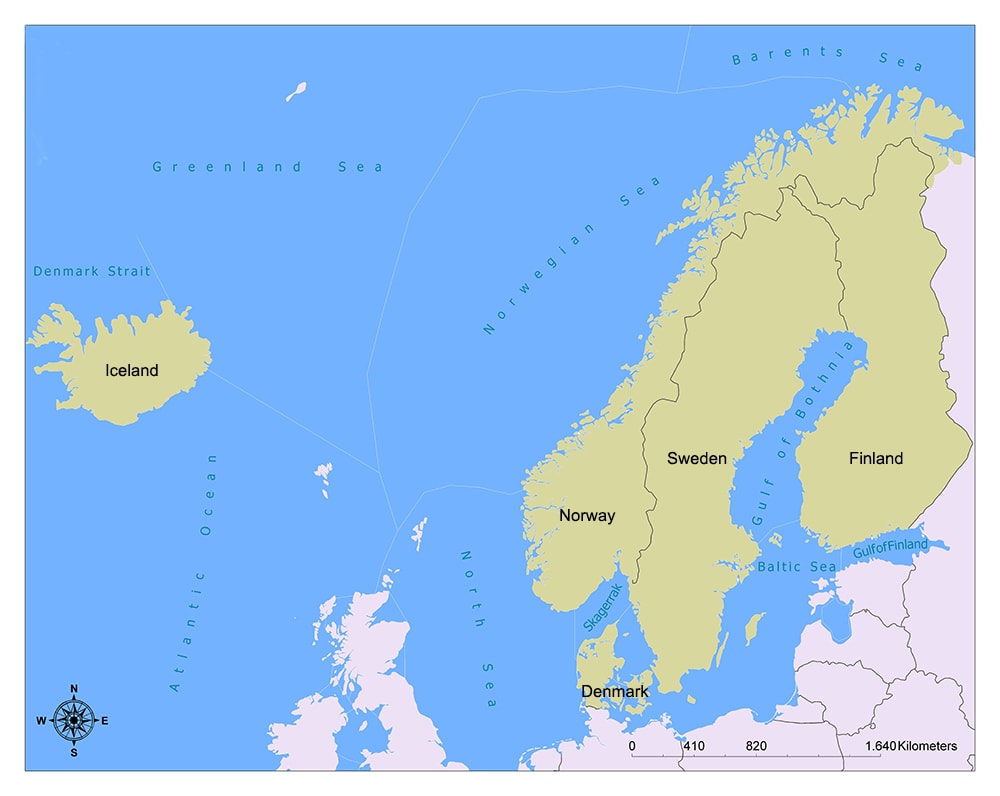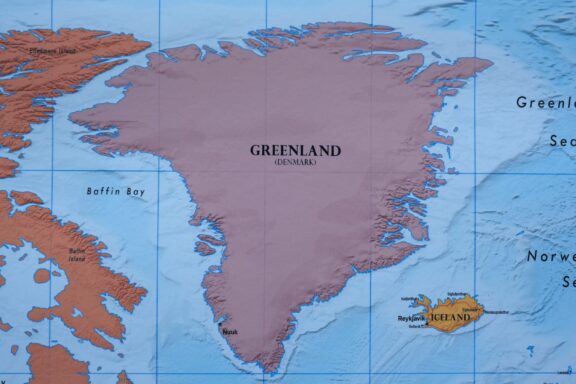The Nordic countries term is the name given to the geography that Iceland, Finland, Faroe Islands, Aland Islands, and Greenland brings together.
If we look briefly at their historical background, the region, which includes Sweden, Norway, Denmark, Finland, and Iceland, began to be politically referred to as the Scandinavian Region or the Nordic countries at the beginning of the nineteenth century.
At that time, Sweden offered to establish a Nordic kingdom united by Norway and Denmark. Norway, however, chose to enter the Swedish Monarchy, while Denmark added the independent islands of Iceland, the Faroe Islands and Greenland to its territory. In the meantime, Russia dominated Finland and prevented any political union with Finland’s Scandinavian countries.

The current geographical association among these countries was, in fact, a unified Scandinavian country and a common historical and cultural heritage. This idea was developed mainly by Sweden, Norway, and Denmark. In the Norwegian national anthem, these three countries are referred to as three brothers. In the late 1800s, the Scandinavian Financial Association was established and the foundations of economic unity were laid.
Norway, however, declared its independence in 1905 and left the Swedish union. Still, Scandinavia continued his passion. Thus, the idea of a common nation and common domination that emerged with this historical sociopolitical proximity continued to exist as Nordic countries or Scandinavian countries, even though these countries declared their independence.
Nordic Countries
The answer to the question of Nordic countries is not only Sweden, Norway and Denmark. Iceland, Finland, Faroe Islands, Aland Islands, and Greenland should also be added to these countries.
Sweden is a country with a high level of prosperity but is quite expensive. 2 million people live in the capital of Stockholm. In the city, there are 14 islands that are connected by 50 bridges. Around the city, there are 24 thousand islands on the Baltic Sea coast. Nearly thirty percent of the city consists of water channels and thirty percent consists of green areas. Stockholm is Europe’s third city in terms of air quality.
Norway extends north-south to the west of the Scandinavian Peninsula. The Kingdom of Norway ranks first in the OECD Quality of Life Index and Democracy Index. Norway is a real fjord. Steep slopes, glaciers, unspoiled forests, rocky islands, and quality of life is one of the most beautiful countries in the world. 600 thousand people live in Oslo, the capital and one of the most expensive cities in the world. The city is extremely peaceful.
Denmark is a cultural and geographical bridge between the mainland of Europe and the Scandinavian Peninsula. One million people live in Copenhagen. The Vikings, who reigned here until the late eleventh century, are still like the symbol of the country today. In the meantime, the famous storyteller Andersen is also lived here and the street where his house is located is quite impressive with its historical structure.
Iceland comes first to mind, volcanoes, legends, the Vikings and the northern lights. The country is known for its extremely peaceful and calm life. Europe has the lowest population density in this country. Its nature is extremely virgin. Hot water geysers, waterfalls, volcanic and geological activities, as well as the level of prosperity is remarkable. Lava fields, glaciers, and mountains are the areas of interest.
Finland is a country with more than 200 thousand lakes and maybe more islands. Cute towns, regular cities, wooden architecture, design art, and dense forests must be seen. In the north of this country, in the summer, the sun never disappears, in the south, it sinks late and there is no darkness at all. In winter, the sun is not born in the north, and in the south, it appears for several hours a day. Capital Helsinki is located in the south of the country.
Faroe Islands (Denmark) – is a country that is connected to Denmark but has an autonomous local authority between Norway and Iceland, where the Norwegian Sea and the North Atlantic Ocean meet. One of the 18 islands of the archipelago, the Forea Islands are famous for their goats and are also known as goats. Its capital is Torshavn and it is the smallest capital in the world. The population of the country is around 49 thousand.
The Aland Islands (Finland) is an autonomous region of about 6,000 islands between Finland and Sweden. Despite its affiliation to Finland, its 30,000 population speaks Swedish and is culturally closer to Sweden.
Greenland (Denmark) is the largest island in the world and is covered with a large ice mass. There are not many tourists going to this deserted country. The country’s population is not even 60 thousand. The capital city of Nuuk is the most populous city and only 15 thousand people live here. They have magnificent glaciers, fjords, and colorful wooden houses that are not visible. The people are predominantly Central Asian origin Inuit.

Nordic Countries List
| Country | Population |
|---|---|
| Sweden | 10053135 |
| Norway | 5,400,916 |
| Denmark | 5775224 |
| Iceland | 340566 |
| Finland | 5,561,389 |
| Faroe Islands | 49000 |
| Aland Islands | 60000 |
| Greenland | 56673 |
Features of Nordic Countries
When it comes to the features of Nordic countries, fjords and northern lights come to mind.
Fjords in Bergen, Norway attract the attention of the whole world. To see these fjords in the north of the city you need to take the ferry. These fjords are found on all the coasts adjacent to the poles. The fjords are the gulfs formed by the lower part of the glacial valleys of the deep and steep slopes formed by the ancient glaciers. Bergen fjords are a sight to see during the train journey, which is a must-see for the fascinating beauty of the fjords.
The second major feature of the Nordic countries is the northern lights, especially in the northern regions of these countries. These lights are a fascinating show of blue, purple, yellow, green lights that appear in the midnight sky. It is mostly possible to watch this fascinating celestial event in Greenland, Iceland, and Scandinavian countries. Northern lights emerge with the interaction between the corona and the earth’s magnetic field, the outer layer of the sun. The South Pole has these lights, but it’s not as impressive as here.